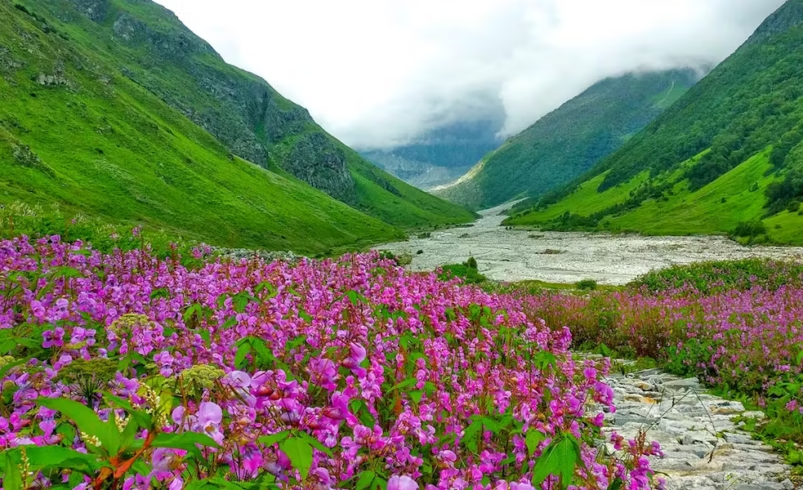Exploring the Valley of Flowers: A Monsoon Trek in Uttarakhand

Hidden in the majestic folds of the Western Himalayas, the Valley of Flowers in Uttarakhand is one of India’s most enchanting natural wonders. Blanketed in vibrant blooms during the monsoon season, this UNESCO World Heritage Site is a paradise for nature lovers, trekkers, and photographers alike. The journey to this alpine valley is not just a trek—it’s a soulful experience filled with awe-inspiring landscapes, serene trails, and a rare glimpse into a flourishing ecosystem that comes alive when the rains descend.
If you’re passionate about trekking in Uttarakhand, especially during the monsoon months, the Valley of Flowers trek is an absolute must-do. Here’s everything you need to know about this spectacular adventure.
The Beauty of the Valley
The Valley of Flowers is located in the Chamoli district of Uttarakhand, nestled at an altitude of approximately 3,658 meters (12,000 feet). During the monsoon season, from mid-July to early September, the valley transforms into a colorful carpet of over 500 species of wildflowers. Orchids, poppies, marigolds, daisies, and primulas bloom in riotous hues, set against a backdrop of misty mountains and cascading waterfalls.
Unlike the stark terrain of many Himalayan treks, this valley offers soft, lush meadows, blooming flora, and a fairytale-like setting that’s hard to believe until seen with your own eyes.
Starting the Journey: Getting to the Valley
The journey to the Valley of Flowers begins in the sacred town of Haridwar, a key pilgrimage site located on the banks of the Ganges. From here, you travel to Govindghat—the base for the trek—via Joshimath, a scenic hill town that serves as the gateway to several popular treks in the region.
The trek starts from Govindghat and involves a 14-kilometer uphill walk to Ghangaria, a small village nestled at 10,000 feet, which serves as the last human habitation before entering the valley. From Ghangaria, it’s a 4-kilometer hike to the Valley of Flowers, and an optional additional trek to Hemkund Sahib, a revered Sikh pilgrimage site situated at 4,329 meters.
Trekking in the Monsoon: A Unique Experience
Monsoon may not seem like the ideal time for a high-altitude trek, but it is the best season to witness the Valley of Flowers in its full glory. The rain breathes life into the meadows, with new blossoms appearing each day. The scent of wet earth, the sound of distant thunder, and the play of clouds drifting across jagged peaks create an atmosphere that is mystical and refreshing.
While the trails can be slippery and mist may obscure distant views, these factors only enhance the sense of intimacy with nature. For many, trekking in Uttarakhand during the monsoon brings a deeper appreciation of the natural world’s delicate cycles.
Flora, Fauna, and Natural Richness
The Valley of Flowers is not just about vibrant blossoms. It is also home to rare and endangered species like the Blue Poppy, Cobra Lily, and Brahma Kamal. If you’re lucky, you may spot Himalayan black bears, musk deer, or even the elusive snow leopard from afar.
Bird lovers will delight in sightings of Himalayan monals, snow pigeons, and yellow-billed choughs. The diverse ecosystem thrives due to minimal human interference, making it a haven for conservationists and wildlife enthusiasts.
Cultural Significance
This sacred region is steeped in mythology. According to Hindu legends, it was here that Hanuman found the Sanjeevani Booti—a life-saving herb to revive Lakshmana in the Ramayana. The trek to Hemkund Sahib adds a spiritual dimension to the journey, where pilgrims chant hymns beside a glacial lake that reflects surrounding snow-clad peaks.
This blend of natural splendor and spiritual reverence is what makes trekking in Uttarakhand such a uniquely fulfilling experience.
Challenges and Preparation
Though not technically difficult, the Valley of Flowers trek requires moderate fitness. The trail includes steep ascents, narrow paths, and occasional rain showers that can make the route slippery. Trekkers should be prepared with:
- Waterproof hiking boots
- Rain gear and quick-dry clothing
- Layered clothing for temperature changes
- Walking sticks for balance
- Basic medication for altitude sickness
It’s advisable to spend a day in Ghangaria to acclimatize before heading to the valley or Hemkund Sahib.
Sustainable Trekking Practices
As more trekkers discover the Valley of Flowers, it becomes increasingly important to practice responsible trekking. Avoid littering, stay on marked trails, and respect the fragile flora by not picking flowers. Supporting local homestays and guides also helps maintain the region’s economy and encourages sustainable tourism.
Final Thoughts
The Valley of Flowers is more than just a trek—it’s a living, breathing canvas of nature’s most vivid expressions. For those seeking beauty, peace, and a bit of adventure, this monsoon trek offers a profound connection with the Himalayan wilderness. It showcases the very best of trekking in Uttarakhand, merging ecological wonder, spiritual depth, and natural beauty in a single unforgettable journey.
So if you’re planning your next monsoon getaway, step away from the usual routes and let the Valley of Flowers enchant you. In every raindrop and every petal, you’ll discover a world untouched by time—a world that exists only for those who seek it.




